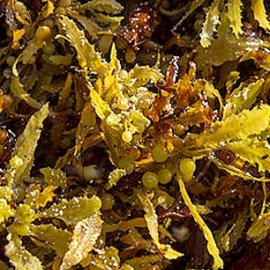The Sargasso Sea
-
English
-
ListenPause
[intro music] Welcome to World Ocean Radio… I’m Peter Neill, Director of the World Ocean Observatory. I am often asked how it is possible to understand, much less advocate, for something as vast, dynamic, and complicated as the ocean. My thought has been to document and describe for the public every aspect of the ocean, a task that is outright impossible by virtue of my limited time and understanding. One tactic is to release the power of metaphor, to find one feature that is both symbol and reality of all the rest. There is such a place: it is called the Sargasso Sea. First, the area, located in the Atlantic Ocean, off Bermuda, is specifically defined, not by land, but by surrounding sea, four ocean currents: North Atlantic to the north, Gulf Stream to the west, Equatorial to the south, and Canary to the east, dynamic flows that circumscribe the space as a gyre, turning clockwise, deep and clear and ecologically unique. It is a natural intersection, as if the epicenter of all oceanic systems, rich in biology, marine wildlife, and Sargassum, accumulation of ‘golden’ algae in floating rafts, on, in, and under which ocean life teems with vitality. It is a place for spawning, breeding, nesting, and feeding, for migrating birds and whales, for sharks, sailfish, tuna, marlin, wahoo, and dolphin, for resident, sheltering eels, turtles, crustaceans, bacteria and other microscopic creatures. It shelters seamounts, ridges, and coral reefs. It enables temperature, oxygen production and carbon sequestration. It mixes the exchange of value from its underwater sources. It is an encyclopedia of ocean knowledge and exceptional area for research and monitoring of ocean systems. While perhaps not as extensive as other wild places, it is certainly as vital as any natural environment on Earth. It is also a place for human endeavor: for shipping, fishing, harvesting, polluting, plastic in all its forms, discarded the world over and brought by ocean circulation to this one fluid, intense concentration of waste much publicized as “the North Atlantic Garbage Patch.” The Sargasso Sea is an evocative symbol and distinctive reality of all the forces that characterize the ocean and its interconnections to all aspects of life on Earth, human and otherwise. As such, it both real and ephemeral, particular and general, nurturing and destroying, embodying both the problems and solutions, questions and answers we seek to study, explain, and conserve. Ironically, while so dramatically affected by human behavior, it exists on the high seas, mostly outside the exclusive economic zone of Bermuda, and thus beyond authority and regulation by any state or government. Some 50% of the ocean area exists in this socio-political limbo; again, Sargasso stands for the challenge to all that unregulated, unprotected area beyond any encompassing framework for national jurisdiction. How, then, do we protect and conserve such a place? On March 11, 2014 governments came together in Bermuda to sign the Hamilton Declaration on Collaboration for the Conservation of the Sargasso Sea, the result of a two-year negotiation between interested governments that are either located in the broader Sargasso Sea area or have an interest in high seas conservation. The Hamilton Declaration was initially signed the Azores, Bermuda, Monaco, United Kingdom and United States, who were later joined by the British Virgin Islands, the Bahamas, Canada, the Cayman Islands, and most recently the Dominican Republic. The Sargasso Sea Commission was thereafter formed to: 1) promote international recognition of the unique ecological and biological nature and global significance of the Sargasso Sea; (2) encourage scientific research to expand existing knowledge of the Sargasso Sea ecosystem in order to further assess its health, productivity and resilience; and (3) develop proposals for submission to existing regional, sectoral and international organizations to promote the objectives of the Hamilton Declaration. Various sectoral organizations that have joined this effort include: The International Commission for the Conservation of Atlantic Tuna (fisheries), the United Nations International Maritime Organization (shipping), and the International Seabed Authority (mining), plus other non-governmental organizations and academic institutions, creating a network of protection measures toward the establishment of an International Marine Protected Area. It is a determined work in progress. For further information, go to: sargassoalliance.org. Reality? Symbol? Both must endure as a force for our personal commitment to the world ocean. We will discuss these things and more in future editions of World Ocean Radio. [outro music]
This week on World Ocean Radio we discuss the Sargasso Sea--a verdant, vital ecosystem that supports a great diversity of life, provides shelter for marine mammals, and serves as a repository for much of the spoils of human endeavor: shipping, fishing, harvesting, and pollution. And we discuss conservation efforts including the Hamilton Declaration and the formation of the Sargasso Sea Commission, protection measures working toward the establishment of an International Marine Protected Area.
About World Ocean Radio
Host Peter Neill provides coverage of a broad spectrum of ocean issues from science and education to advocacy and exemplary projects. World Ocean Radio, a project of the World Ocean Observatory, is a weekly series of five-minute audio essays available for syndicated use at no cost by college and community radio stations worldwide. Contact director@thew2o.net if you are interested in becoming an affiliate or know of a radio station that should be broadcasting these episodes each week.
Image
Lines of sargassum can stretch for miles along the surface of the Sargasso Sea. The clumps of floating algae are often concentrated by the strong winds and wave action associated with the Gulf Stream. Credit: Ocean Explorer | NOAA
- Login to post comments



